English Electric Canberra
A legend is born…
The Canberra can be classed as one of the greatest aircraft of all times, it was the first jet bomber to enter service with the Royal Air Force, the German Arado Ar 234 “Blitz” being the worlds first. Near the later stages of WW2 the UK Ministry of Aircraft Production was looking for a jet bomber to replace the Hawker Typhoon in the role of fighter-bomber.
The first request for the replacement jet bomber was for an aircraft with approximately 40,000lbs “all-up-weight” that would be powered by a single 12,000lb thrust engine mounted in the rear fuselage. By the end of 1945 these specifications had changed to a high-speed two-crew bomber and given the title B3/45.
In early 1946 a contract was placed with the English Electric Company for four prototypes of the English Electric A.1. The first wooden and cardboard mock-up was produced in a garage in Coronation Street, Preston.
For three and a half years the building of the prototypes continued and by mid 1949 the first of them had been constructed at English Electric’s airfield at Warton and in May of 1945 VN799 was rolled out.

After a number of engine tests, she was fitted with a pair of Rolls-Royce RA1s engines, and undertaking a series of short “hops” down the runway, the big day of the first full test flight of the Canberra A.1 arrived. On Friday 13th May 1949 VN799, painted all blue, took to the skies, flown by English Electric’s chief test pilot, Roland Beamont the flight lasted twenty-seven minutes and the only issue reported during the flight was a very slight over balanced rubber. This was quickly fixed by removing part of the “horn” balance; this gave the aircraft its well known square cut tail fin. The other three prototypes, VN813, VN828 & VN850 were quickly modified before their first flights.
Test flying of VN799 continued throughout 1949, in September of that year she had her first public appearance at the Farnborough Air Show, Roland Beamont undertook a short take-off then put the Canberra into almost vertical climb and then did a number of high and low level high speed passes. The Canberra was the Queen of the show; no-one was left in any doubt of its design and flying merits.
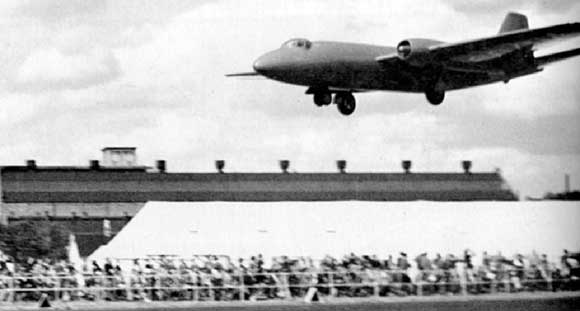
The remaining three prototypes all made their test flights in the final months of 1949.
Because of the way in which the test programme was progressing to well, other problems started coming to light. The bombing radar equipment was well behind in development and as such there were calls for a revised variant of the aircraft. So another four prototypes were constructed under specification B5/47 and called the B.Mk2. The delayed B.1 was to be designed with a crew of two sitting side-by-side, the B.Mk2 variant had a provision of a third crewmember, a bomb aimer. The first B.Mk2 was VX165 which made its maiden flight on 23rd April 1950. She was quickly followed by VX169; both these aircraft were equipped with the Rolls-Royce Avon RA3 engines. These engines would be the type that would be fitted to the Canberra’s already on the production line.
The first “true” production produced Canberra B.Mk2 was WD929, which was part of the initial batch of seventy aircraft. WD929 first flow on 8th October 1950 and was released for RAF service in April 1951. It was WD2929 that was christened “Canberra” by the Australian Prime Minister of the time Sir Robert Gordon Menzies in January of 1951 at RAF Biggin Hill.
On the 25th May 1951 the first operational was equipped with the Canberras, 101 Squadron at RAF Binbrook became the first Squadron in RAF Bomber Command history to be equipped with jet bombers. During this period of time Bomber Command was still equipped with mostly Avro Lincolns and Boeing Washington’s. The dawn of a new era was being written in RAF history.
Main Variants of the Canberra
During 10 years of production 782 were produced by English Electric and her sister companies, 48 were built under licence in Australia, 403 were again built under licence in the USA for the USAF, by Martin Company in Baltimore.
There were a total of forty variants of the Canberra; this includes thirteen for the USAF.
B.Mk1
Crew – Two
Engines – Rolls-Royce Avon Mk.1/RA2, with 6,000lbs thrust each engine.
Total Fuel Load – 10,992lbs
Maximum Bomb Load – Unknown

This was the four prototypes built to specification B3/45. Designed as a medium bomber with a “solid” nose and manned by a crew of two who sat side-by-side. It was intended that bomber aiming would be undertaken by radar.
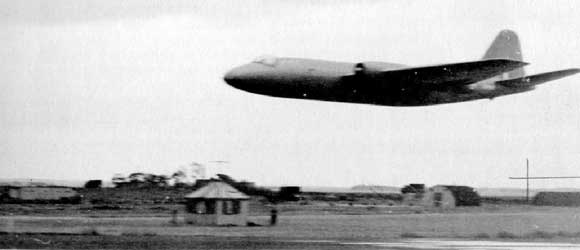
B.Mk2
Crew – Three.
Engines – Rolls-Royce Avon Mk.1/RA3, with 6,500lbs thrust each engine.
Total Fuel Load – 10,992lbs
Maximum Bomb Load – 10,000lbs
This was to be the main variant of the Canberra and 418 were built. Very similar to the B.Mk1. However; it was fitted with a transparent nose-cone, used as the bomb aiming position and being classed as a light tactical bomber. Unlike the B.Mk.1 this variant had one seat on the port side for the pilot and two seats behind this for the other members of the crew. In later years a number of redundant B.Mk2s were converted to later marks and also this mark was exported to a number of other countries, Argentina, Australia, Ethiopia, Peru, Rhodesia, Sweden, USA, Venezuela & West Germany.
PR.3
Crew – Two (Pilot & Navigator)
Engines – Rolls-Royce Avon Mk.1/RA3, with 6,500lbs thrust each engine.
Total Fuel Load – 15,336lbs
Maximum Bomb Load – None
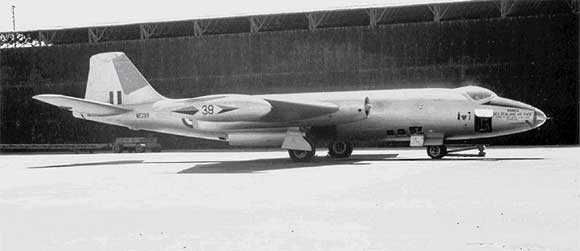
Basically the PR.3 was a B.Mk2 with 14in extension in the front fuselage; this was to accommodate extra fuel, a camera bay and a flare bay. With the capability of being fitted with 7 cameras this variant was designed for high altitude photographic reconnaissance.
The first PR.3 flow on the 19th march 1950 and enter service in November 1952. Only thirty five were ever produced. It was later to be replaced by the PR.7. Two of this version was supplied to Venezuela as PR.53’s.
T.Mk4
Crew – Three (Two Pilots & Navigator)
Engines – Rolls-Royce Avon Mk.1/RA3, with 6,500lbs thrust each engine.
Maximum Bomb Load – None
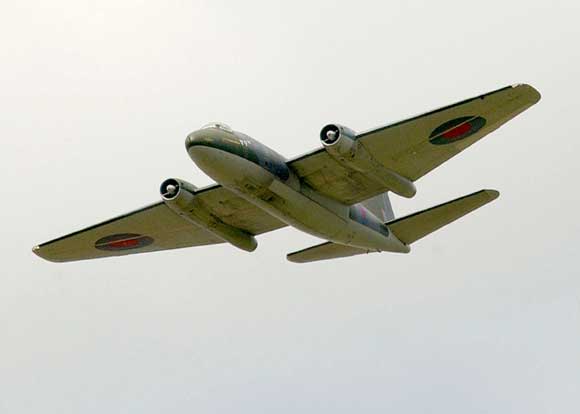
Another development of the B.Mk2, this variant was designed to the meet the requirement of an operational trainer. Fitted with side-by-side seats and full dual controls for the pilots, the navigator’s seat was set behind those of the pilots. This made for a cramped cockpit. The T.Mk4 retained its bomb-bay, however, it was not used for bombing training as its bomb beams and associated equipment being removed thus making it 7,000lbs lighter that the B.Mk2
B.Mk5
Crew – Three
Engines – Rolls-Royce Avon Mk109/RA7, with 7,500lbs thrust each engine.
Total Fuel Load – 23,672lbs (for Trans-Atlantic record)
The second prototype of the PR.3 was converted to the only B.Mk5, serial number VX185. It was to be a target-marker with an improved radar system. It was also fitted with integral leading edge wing fuel tanks, giving 900 gallons of extra fuel. In 1952 VX185 crossed the Atlantic and returned in just over 10 hours and 23 minutes, setting a new record, just one of a number for the Canberra.
The mark was never placed into production and VX185 later was converted to a B(I).Mk8.
B.Mk6
Crew – Three.
Engines – Rolls-Royce Avon Mk.109/RA7, with 7,500lbs thrust each engine.
Total Fuel Load – 10,992lbs
Maximum Bomb Load – 11,280lbs
There was no prototype for the B.Mk6, a total of ninety-nine were produced, fifty built by English Electric and forty-nine by Shorts Brother. The B.Mk6 started to enter service from November 1955, similar to the B.Mk5 with a glazed nose.
This variant was usually fitted with systems to undertake low altitude bombing, with some being fitted with “Blue Shadow” radar and would only have a crew of two.
Apart from its normal bomb load the B.Mk6 could carry tactical nuclear weapons, all these weapons were carried internally.
This variant of the Canberra was also supplied to Ecuador, France, India & Peru.
B(I).Mk6
Converted from the B.Mk6, this variant was designed as a night interdictor and only twenty were ever built. The first B(I).Mk6, WT307, flow for the first time on the 31st March 1955.
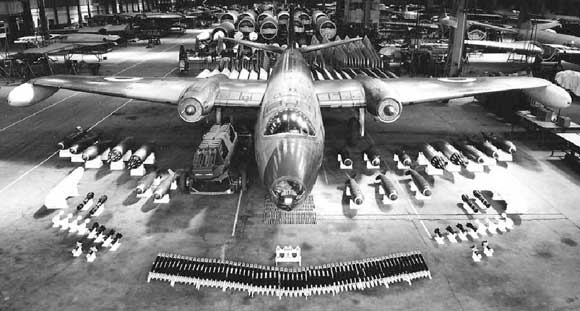
Seeing only service with No. 213 Squadron RAF in West Germany, the aircraft were equipped with a four 20mm cannon in a blister mounted in the rear part of the bomb-bay. Also under-wing points were added so there was the provision for the aircraft to carry two 1,000lb bombs or packs of 2in rockets.
This variant was only designed as an interim until the B(I).Mk8 came into service.
PR.7
Crew – Three.
Engines – Rolls-Royce Avon Mk.109/RA7, with 7,500lbs thrust each engine.
Total Fuel Load – 15,336lbs
Maximum Bomb Load – none

Again no prototype was produced for this variant as most of the changes had been checked-out on VX185 the B.Mk5.
Designed to replace the PR.3 in the photographic reconnaissance role, the PR.7 was to remain in service with the RAF for over twenty years. For its reconnaissance role, the PR.7 could be fitted with six cameras in the centre fuselage and a survey camera in the rear fuselage.
This second variant of the photographic reconnaissance Canberra was ordered as an upgrade of the PR.3; however, only one example of the seventy four built was converted as such. The others were produced as PR.7s and deliveries start in November 1953 through until July 1954.
English Electric in 1953 received a request to develop a PR.7 to reach an operation height of over 60,000ft with the use of Roll-Royce Avon 206 engines and this was to be called the “High Altitude” HA PR.9. WH793 was modified for the trials, so with new engines and an enlarged wing area the prototype was flown on 8th July 1955. After a number of flights on the 18th September 1956 the highest altitude was reached 59,800ft. With these and other developments a totally re-designed Canberra for reconnaissance and other roles would be seen.
In November of 1956, a PR.7 WH799 of 58 Sqn, but flying with 13 Sqn, was undertaking a photographic reconnaissance mission over Syria on the last day of the Suez War. The aircraft was engaged by Syrian fighter, possibly a MiG-15, killing the navigator, with the other crew members being captured. This is the only known instance of a photographic reconnaissance Canberra being shot down.
The PR.7 was also supplied to the Indian Air Force as the PR.67
B(I).Mk8
Crew – Two
Engines – Rolls-Royce Avon Mk.109/RA7, with 7,500lbs thrust each engine.
Maximum Bomb Load – 10,000lbs

The B(I).Mk8 was designed to undertake a number of roles, they being as a long range night interdictor, a high altitude bomber or as a target maker. The aircraft could be converted from one role to another.
In total fifty seven airframes were produced, with the prototype first taking to the skies on the 23rd July 1954. The first production aircraft came into service with the RAF between July 1955 and July 1956. The rest of the production was released to the RAF in October 1956.
Slight similar to the B(I).Mk6, this variant had a completely revised nose which was fitted with a transparent nose-cone for low-level bombing and navigation. The pilot’s position was also changed. He could now be found sitting under a fighter type bubble canopy off-set on the port-side of the nose. The navigator/bomb aimer was position below and to the right of the pilot.
When in the bombing role the B(I).Mk8 could carry either of the following, six 1,000lb bombs, or one 4,000lb bomb and two 2,000lb bombs or eight 500lb bombs, all these would have been fitted internally, also with any of these, it could carry up to 2,000lbs of stores on under-wing points. In the interdictor role it would be fitted with a pack of four 20mm cannon mounted in a blister installed in the rear of the weapons bay in which either sixteen 4½in flares or three 1,000lb bombs. The B(I).Mk8 was also equipped to carry two packs of 37 rockets, these being mounted externally and the “Nord” air-to-surface missile. This variant could also be equipped to deliver nuclear weapons.
The B(I).Mk8 was also exported to Peru & Venezuela.
PR.9
Crew – Two
Engines – Rolls-Royce Avon Mk206/RA24, with 11,250lbs thrust each engine.
Total Fuel Load – 15,336lbs
Maximum Bomb Load – none
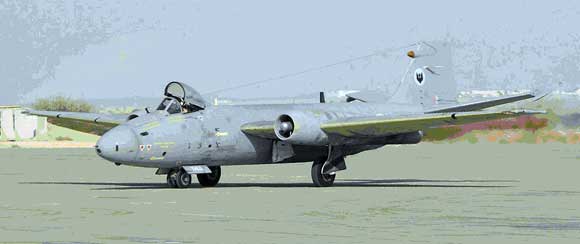
This variant of the Canberra was the last to be produced. Designed for the role as a high altitude photographic reconnaissance aircraft, The PR.9 was produced by Short Brothers of Belfast. A total of thirty two were ordered, but only twenty five were ever built.
The prototype PR.9 WH793 first took to the skies on the 8th July 1955, it had started life as a PR.7. The rest of the fleet of aircraft were delivered to the RAF between September 1958 and December 1960. The PR.9 had the same basic fuselage as the PR.7 but with the upgrade nose. Fitted with broader wings and unlike the B(I).Mk8, the pilots canopy could open! The PR.9 was designed to carry a wide range of camera installations.
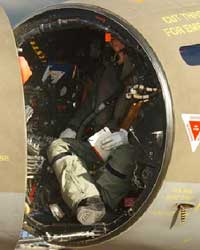 A major design was the provision of an automatic ejector seat in the nose for the navigator; this meant a complete re-design of the nose section. In the revised layout, the photographic control systems were placed on the port side of the compartment, the main navigation equipment was position forward of the seat and various other controls on the starboard side. In later years, other camera controls were added to this side.
A major design was the provision of an automatic ejector seat in the nose for the navigator; this meant a complete re-design of the nose section. In the revised layout, the photographic control systems were placed on the port side of the compartment, the main navigation equipment was position forward of the seat and various other controls on the starboard side. In later years, other camera controls were added to this side.
A hinged chart table was also fitted and in flight, this would rest on the navigator’s knees. For photographic tasking a periscope sight was mounted again in front of the navigator.
The PR.9 was the last Canberra variant in service with the RAF and in July 2006 it retried from service. So from the date of the first flight, The PR.9 had completed 51 years of service!
All Canberras used by the RAF after the PR.9 was conversions of the B.Mk2 type, with only one being an upgraded from a PR.7.
A number of these were highly specialised upgrades, other being upgraded to their type.
U.Mk10
The U.Mk10 was an unmanned target aircraft. It’s used a target for guided weapons trials. This conversion was carried out by Short Brothers and at the time, the design of the U.Mk10 placed the UK ahead of other countries including the USA in this field. It first went into service in 1959, the airframe being WD961.

Remote-control of the U.Mk10 during flight was maintained from a master ground control. The controller’s commands would be transferred by a VHF radio link to an airborne receiver, and then the signals would be passed onto the drone. Under automatic control, the U.Mk10 could be flown at altitudes of 50,000ft.
The U.Mk10 had fitted in place a system where if there were any problems with the aircraft an explosive change could be detonated and this would sever the tail section.
A total of twenty six U.Mk10 were produced, six from the RAF, these being flown from Malta and the other for the Royal Australian Air Force.
T.Mk17
The T.Mk17 was converted as Electric Countermeasures (ECM) trainer and only equipped one squadron within the RAF, No. 360 Squadron, which in fact was jointly by both Royal Air Force and Royal Navy personnel.
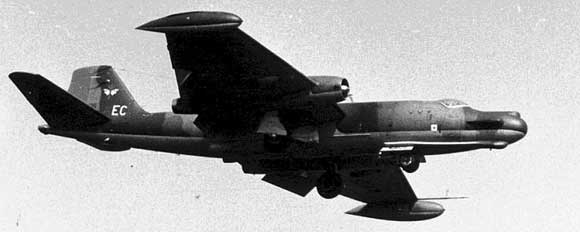
This Squadron formed from B Flight of No. 97 Sqn RAF and No. 831 Sqn Royal Navy in September of 1966. As can be seen from the image, the T.Mk17 had a number of blisters mounted on the nose cone; these were part of the system that provided electric countermeasures and radar jamming training to all members of the three UK services.
Only twenty four T.Mk17s were produced, the last in 1968 and carried the serial number WH872.
Conclusion
The Canberra not only served with the RAF but a number of other countries around the world.
These being Argentina, Chile, Ecuador, Ethiopia, France, Germany, India, New Zealand, Peru, Sweden, South Africa, Venezuela and Zimbabwe/Rhodesia.
Also it was manufacture overseas under licence to Australia and the United States, who supplied to both Pakistan and Taiwan.
With over 50 years service to the Royal Air Force and other nations world-wide, the English Electric Canberra should be classed as a classic aircraft and should be seen as one of the world’s most highly successful military aircraft. It played a major role in the UK’s contribution in maintaining peace at home and in distance lands.
![canberra-india-928 Sample used by India [color profile- Srecko Bradic]](http://www.letletlet-warplanes.com/wp-content/uploads/2009/05/canberra-india-928.jpg)
In its heyday it held twenty four world records, ranging from the world altitude record of 70,310ft set on 28th June 1955 to London UK to Christchurch, New Zealand in just under twenty four hours and in 2006 the PR.9 was still in front line service with the RAF.
I for one am honoured that I worked with the Canberra PR.9, it will one of my greatest memoirs.
From its very first public display in 1946, the Canberra held the attention of all those in the aviation world. Here had been produced a bomber that could out fly and fly higher than all the know fighters of the time. And it was British.
Mick Gladwin

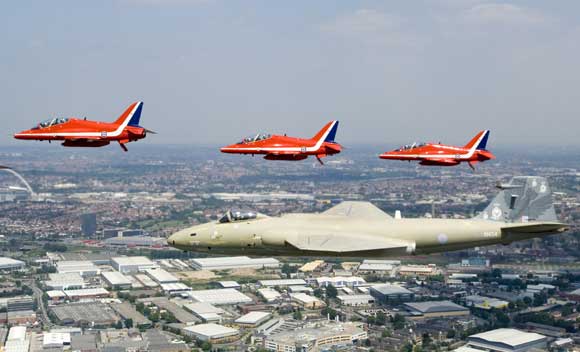


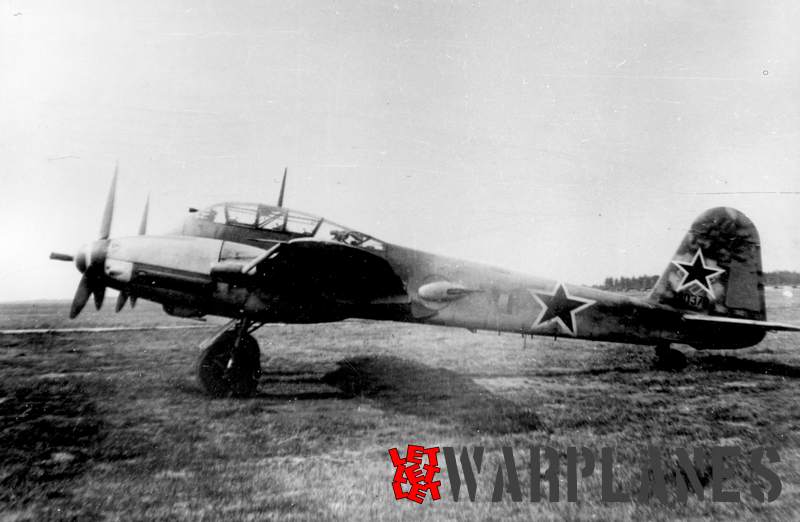
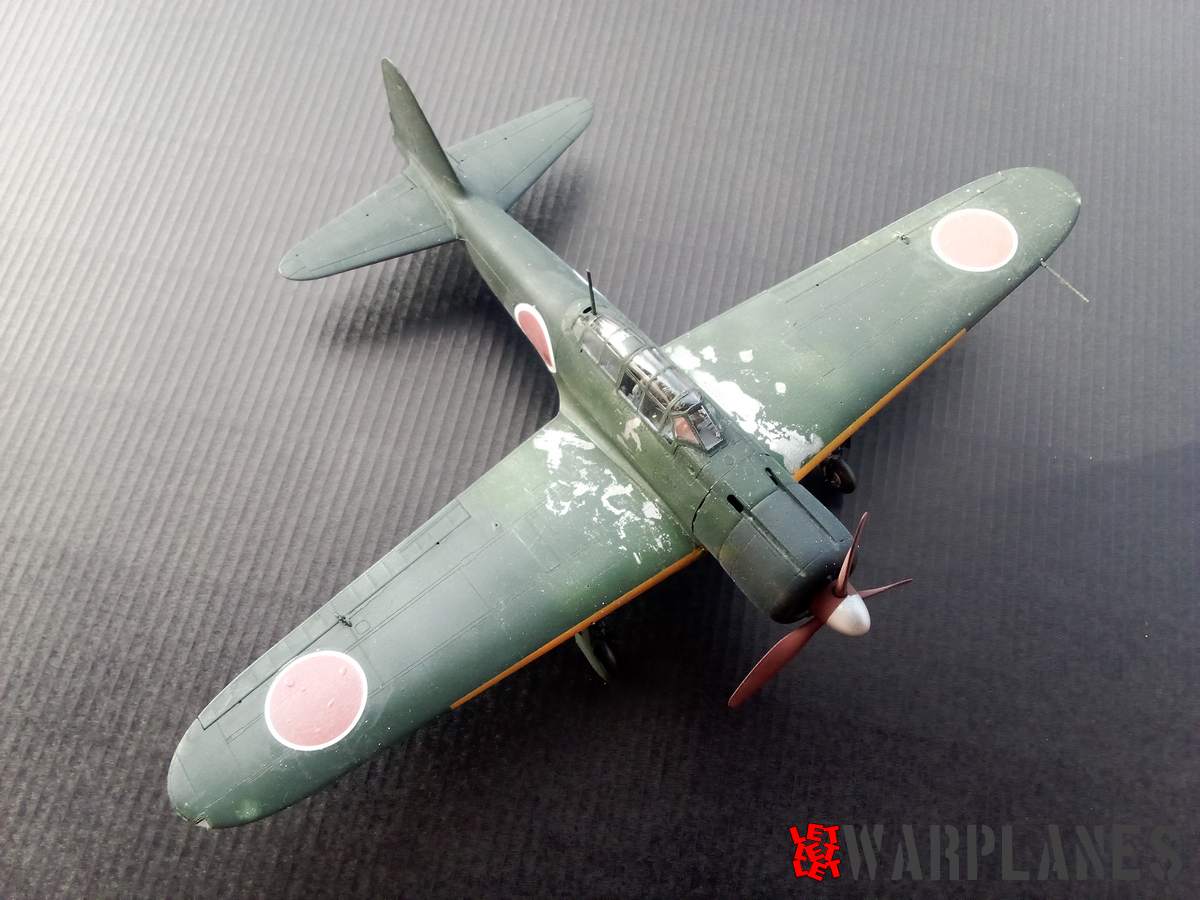

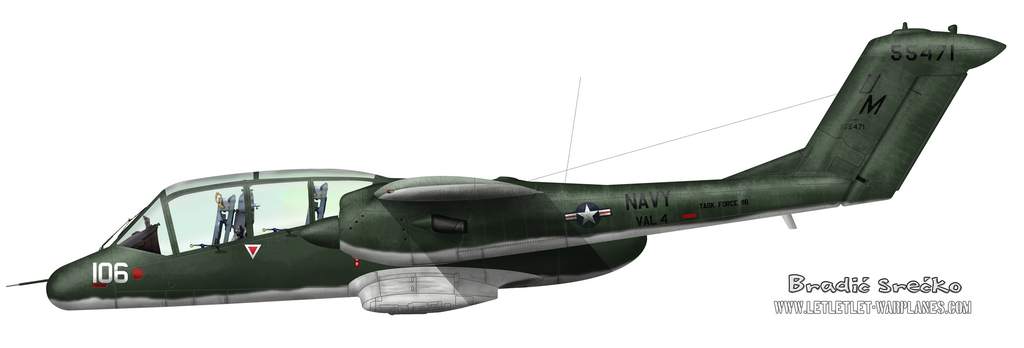
I am trying to find examples of “white” Canberras operating from RAF Tengah in 1958. Only clue I have is Operation Grapple and 76 Squadron “sniffer” aircraft, used for checking H bomb cloud.
From memory 76 Sqdn had 2 white Canberras although all the 76 Sqdn Canberras that were used in Air Sampling operations were painted with a white water soluble paint. This was used as after sampling flights it could be washed off removing with it some of the radiation.
The Grapple operation I was involved with was Grapple Z, for this and some prior Grapple operations the aircraft were based at RAAF Edinburgh Field and were deployed to Christmas Island for the actual bomb tests. I have no knowledge of 76 Sqdn aircraft operating from RAF Tengah. I am pretty sure that 76 Sqdn RAAF were operating in Malaya around that time although I think they were operating Sabres (I would check but sometimes if you navigate away from a page when you return you have to start again). Actually the movement of 76 Sqdn aircraft was somewhat restricted due to “fly over” restrictions operating in some countries. This caused resorting to all sorts of subterfuge when the aircraft returned to the UK in 1960. I do have some old b/w photos somewhere if they are of interest to you. For some reason the RAF Squadron Histories have almost no information on operations during 1950’s.
interesting!i was an airframe tech,on b2’s at binbrook from 53 to 55 (demob) we had one painted white underneath i,m pretty sure it was WE111,we gathered it had flown through an atomic cloud somewhere ,.we used to joke about being sterilized.i dont know if anybody remembers the new zealand air race,but just as a point of interest,i was at raf shaibah,refueling and turning round the canberra that won it.maybe it will stir some memories.